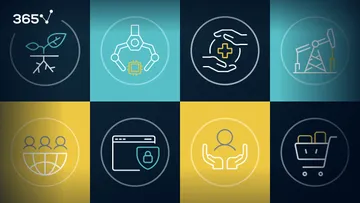Data science has been one of the most attractive career fields in the last couple of years. As companies realize the power of their data and want to use it to drive smart business decisions, the demand for qualified data professionals is continuously on the rise. Many people with non-quantitative background have transitioned into data science either by going back to school to pursue the best degrees to become a data scientist or by balancing work and studies with online data science courses.
And that’s certainly a smart career move.
Data scientist is one of the highest-paid roles in the IT industry, offering plenty of skills development opportunities on the job through various data science projects using different data types to solve diverse problems.
Not only that, but data scientists have a great impact on any organization thanks to their highly prized ability to gain valuable insights from data, thus helping stakeholders develop better strategies, make predictions, analyze market trends, reduce losses, and increase profits.
So, how can you transition your career into data science and find a great data science job, even if you don’t have a computer science degree?
In this article, I will walk you through the steps that will enable you to smoothly shift to data science from any profession.
There’s also a great video on the topic you can watch below or scroll down to keep on reading.
How to Transition to Data Science – Table of Contents:
- Choose a Data Science Role and Evaluate Your Current Skills
- Learn the Technical Skills You Need to Transition into Data Science
- Gain the Soft Skills You Need to Transition Your Career into Data Science
- Put Your Work into Production
- Gather Domain Knowledge
- Showcase Your Skills
- The Power of Networking
- How to Transition Your Career into Data Science: Next Steps
Choose a Data Science Role and Evaluate Your Current Skills
There is a wrong assumption that you should have a higher degree in data science to be able to work in this field. In fact, the definition of data science is constantly evolving because it is a very broad field that you can transition to with different backgrounds. Nevertheless, if you want to start a career in data science, you should master some basic technical and theoretical concepts, as well as use computational tools that translate this knowledge into practice.
In truth, the role of a data scientist is fluid. Therefore, every data scientist will have a unique experience and comprehend their work differently because data science environments are distinct and inimitable.
That said, the first and most important step in your transition to data science is to decide on the domains and the type of data roles that you would like to work in.
Not all data scientists do machine learning modeling – in some companies, the role might require it, but more often than not, you will be expected to focus on analytical and cleaning tasks or the deployment and operational tasks. What’s more, it is important to be well-acquainted with the domain that you would like to work in as this also will affect your transition plan. To make things happen, you will have to choose domain-specific projects and relevant data science skills.
The second point is to evaluate your current skillset based on your education and work experience. Knowing this will help you define your choices and point of strengths and weaknesses which will lead to a better transition plan. For example, if you have a software engineering background it will be better if you target the data science positions that put more emphasis on the deployment and the operational part, as you will have good experience in this. The same goes for non-quantitative degrees. If you have a business background or an economics degree, you can target data science positions in the fintech industry, and so on.
It is important to keep in mind that the field of data science is currently quite competitive, and it is becoming harder and harder to land even an entry-level data science job or a data science internship, especially if you are a fresher. Therefore, it will always be good to know your points of strength and try to target suitable positions, as this will make you stand out from the crowd. Also, you should have flexibility towards the positions. Even if your ultimate goal is to become an SQL developer, data scientist, or machine learning engineer, working in any data-related positions while at the same time building the necessary skills with data science courses is a very good step towards your dream job.
Learn the Technical Skills You Need to Transition into Data Science
As I mentioned, data science is a multidisciplinary field and there are many skills and tools that you will need to master depending on the domain and the main responsibilities of the role. However, whether you want to become a data scientist, data analyst, or business analyst, there are fundamentals you can’t possibly skip.
Assuming you have no technical background, I will list all of them. Nevertheless, you should customize the skills you need to master based on your current experience and competencies.
Mathematics
Learning basic mathematics will act as the theoretical foundation in your journey to data science. Mathematics is an infinite subject, but 2 subfields are essential for every data science professional – calculus and linear algebra. They will enable you to understand complex machine learning and deep learning concepts, as well as develop a strong analytical mindset.
Calculus
Calculus studies the rate of change of quantities and the length, area, and volume of objects. It is an important part of machine learning, extensively used in the optimization of machine learning models.
Linear Algebra
Linear algebra explains linear equations and their representation through matrices. Data scientists apply linear algebra techniques not only to transform and manipulate data sets effectively but also to understand how most machine learning and deep learning algorithms work.
If mathematics isn’t one of your strengths, you can try 365 Data Science’s Mathematics course. It covers the important concepts of linear algebra for every aspiring data science professional.
Probability
Probability is concerned with the analysis of random phenomena. The probability theorem is a great place to begin your data science journey, as it is the mathematical foundation of statistical inference and will serve you well once you get to the more advanced topics in machine learning.
Some of the important probability concepts to learn are:
- Independent and dependent events
- Counting theorem
- Discrete & continuous random variable
- Bayesian inference
- Limit theorems
In case you’re new to all this, 365 Data Science provides a Probability course that covers the basics of probability theory and how to apply them as a data scientist.
Statistics
Statistics encompasses the collection, organization, analysis, interpretation, and presentation of numerical data. Considered one of the pillars of data science, it is largely applied in data exploration and analysis, as well as in designing statistical tests and analyses. If you’re a beginner, a very good starting point will be the Statistics course you can find in the library of 365 Data Science courses.
Programming
Programming is without a doubt a must for every data science professional. Using computational concepts when working with large data sets allows you to easily model them and visualize the results. And this is just a tiny part of the countless applications of programming in data science. Although there are many languages worth learning if you want to get hired as a data scientist, Python (number 1 in the TIOBE Index and the PYPL Index) and SQL (the 3rd most popular technology among professional developers, according to the StackOverflow Developer Survey) have taken the lead in recent years.
Python
The most wanted programming language in data science, Python, is easy to learn, boasts a huge community you can turn to with your questions and problems, and has an impressive set of data science libraries for most of the tasks you’ll be required on the job.
Some of the skills you need to be confident in are:
- Constructing conditional statements in Python
- Working with loops in Python
- Python functions
- Data structures
- DataFrames
- Object-oriented programming
All of these are covered in the Introduction to Python course in the 356 Data Science Program. By all means, once you learn the basic programming concepts, you should practice using different Python libraries for data cleaning and preprocessing, data modeling, data visualization, and deployment into production.
There are plenty of Python libraries for these tasks. However, I suggest you master the most popular ones: NumPy and pandas for data cleaning and preprocessing, scikit-learn for machine learning models, Keras and TensorFlow for deep learning models, seaborn and matplotlib for data visualization, and flask for model deployment.
SQL
Structure Query Language (SQL) is a declarative language you will probably use daily as a data scientist. It is the language you need to “communicate” with the database that stores your data. Practically, it allows you to retrieve and extract the data from one or a combination of several tables in the database.
The basic SQL concepts that you need to master are:
- SELECT and WHERE statement for filtering and selection.
- COUNT, SUM, GROUPBY, MAX, MIN, HAVING for data aggregating.
- DISTINCT, COUNT DISTINCT for producing useful distinct lists and distinct aggregates.
- LEFT JOIN, RIGHT JOIN, and INNER JOIN
- UNION and UNION ALL.
- Strings and time conversions
- SELF JOIN
- Sub-queries and their impact on the query’s efficiency
Knowing how to extract your own data is an invaluable skill in every data professional’s toolbelt. If you feel that you have knowledge gaps in terms of database management and creating SQL queries, try this SQL course (you can watch the first 40 minutes for free!)
Machine Learning
Machine learning is where mathematics meets computer science. Harnessing the computational power of the machines, we can apply mathematical equations to a large dataset to recognize the patterns in the data. Data scientists use machine learning to gain a better understanding of the data, extract insights, and automate decision-making in real-time without human intervention.
Machine learning algorithms are broadly categorized as supervised or unsupervised.
Supervised learning is quite similar to teaching by example – you feed the machine learning model with a training dataset and it’s up to the algorithm to yield the desired output. While you know the correct answers to the problem, the algorithm makes observations and predictions and continuously learns from past mistakes. This way, over time, it achieves a high level of accuracy.
The main tasks that fall under supervised learning are regression and classification. In regression tasks, the model learns the relationships between independent variables and a dependent variable to predict continuous outcomes. In classification tasks, the model learns the pattern for every category and classifies new entries to the category it deems most suitable.
The basic supervised algorithms that you should have a solid understanding of are:
- K-Nearest neighbors
- Linear regression
- Logistic regression
- Support Vector Machines (SVMs)
- Decision Trees and random forests
Unsupervised algorithms work with data that is neither classified nor labeled. The machine learning algorithm identifies patterns and tries to find the underlying structure of the dataset without any supervision. This means grouping the data into clusters based on similarities or finding the relationships between variables in a large dataset using the association method.
Two main tasks fall under unsupervised learning – clustering and dimensionality reduction. Clustering involves grouping similar data together based on their features. It’s useful for segmenting data into several groups and performing analysis on each data set to find patterns. Dimensionality reduction reduces the number of variables or features by transforming the data from a high-dimensional space into a low-dimensional space without losing the meaningful properties of the original data. The unsupervised learning basics you should be well-familiar with are:
- K-means clustering
- Density-based spatial clustering of applications with noise (DBSCAN)
- Principal component analysis (PCA)
- t-distributed stochastic neighbor embedding (t-SNE)
The courses in 365's Machine Learning module are the ideal starting point if you want to build your ML understanding.
After that, you can tackle more advanced topics such as deep learning and its application in computer vision and natural language processing. Of course, your topics of interest depend on the domain and the kind of roles you would like to work in.
Gain the Soft Skills You Need to Transition Your Career into Data Science
The nature of data science jobs requires them to not only be technically thoughtful but also possess the necessary soft skills to help them excel in their roles. Soft skills help data scientists to effectively communicate with the different teams they deal with on a daily basis, critically analyze situations, make decisions, and communicate their results and findings in a better way. Here are some of the most important soft skills you should work on in your transition journey:
- Communication skills
- Critical thinking
- Business acumen
- Storytelling
- Team player
Put Your Work into Production
Despite being one of the most important industry demands, putting your work into production is always overlooked by beginners in the field of data science.
When it comes to machine learning models, a simple method is deploying them as a web service using the Flask web framework for example, and hosting it on any cloud services such as AWS.
Learning to build a dashboard is also very important for every data scientist, as a major part of the job role is reporting your results and insights to the company executives and other teams. And a neat and visually pleasing dashboard is a perfect way to deliver your results and convince others of your findings. Both Tableau and Power BI are great choices for building interactive dashboards. If you’re wondering where to start, try these hands-on Power BI and Tableau courses.
Gather Domain Knowledge
The lack of domain knowledge of the field of environment makes it difficult to apply the right methods and techniques, as well as to evaluate their performance properly. In fact, the application of domain knowledge must be pervasive throughout the data science process to ensure it’s effective. So, it is important to decide which sphere you would like to work in, understand its principles, focus on its business aspect and how and what is being generated, and enhance the data science skills related to it.
Showcase Your Skills
Showcasing your skills is arguably the most crucial step in your career transition. Data science is a very competitive field and, with all qualified job seekers out there, the most difficult step in your job search is to actually get noticed, especially if you are a fresher who doesn’t have any prior experience. One of the best ways to stand out is to build a skill-oriented portfolio simultaneously with learning the relevant skills for the job you want. A great strategy is to apply every new skill you acquire to real-world projects and include them in your data science portfolio. Based on your career goal, you should select what would be an important skill to highlight and what is the best way to show it. You should take into your consideration the domain you would like to work in answering these questions. Among many other data science courses, 365 Data Science offers Starting a Career in Data Science: Project Portfolio, Resume, and Interview Process which guides you on building an outstanding portfolio and resume to easily land your first data science job.
The Power of Networking
As I mentioned above, data science roles are quite competitive and the most difficult part of landing a job is to find a way to pass the application screening successfully. The first way is to capture the attention of recruiters, and that’s no easy feat! But there’s an alternative – skipping this step completely through internal referrals. Internal referrals will not only facilitate your hiring process but will also help you to improve as you will likely get constructive feedback. And the best way to get internal referrals is to build a good network.
Although there are various opportunities to establish a meaningful relationship with successful data scientists, I will focus on the ones you can’t go wrong trying – conferences and social media.
Meetups & Conferences
Attending meetups and conferences is a surefire way to build a strong network. However, you should choose them carefully. Here are some of the important tips to find the best events:
- Focus on the meetups held by interested companies or related to your domain.
- Focus on technical conferences.
- Search for moderate size conferences, which are not too big or too small.
- Search for regularly held events.
Once you find a good meetup, follow the tips below to build a good network:
- Actively attend the events and make sure to make your presence noticed by asking questions and being involved in the discussion during and after the talks.
- Ask the organizers to give a tech talk. This will not only help you develop your network and raise your profile among the organizers and attendees but will also increase your technical know-how.
- Add people you have conversations with on LinkedIn. This will allow for further communication, especially if you are active on the platform. Asking them to meet and grab a coffee and talk more about their job and experience could bring you closer to receiving a referral in the future.
Social Media
Social media is shaping our current world, and it is becoming a very important tool for expanding your professional network. The most important social media sites for data scientists are LinkedIn and Twitter. Here are some tips on how to make the most of them:
- Connect with data scientists that are working in interesting companies
- Interact with them through comments and like what they post
- Post original valuable posts on LinkedIn and Twitter daily
- Share your work such as projects, dashboards, and blogs
This will help you to develop a good relationship with your network which could further turn into one-on-one communication through face-to-face or video meetings. Having a strong online presence will also capture recruiters' attention to your profile, which could give you extra points during the hiring process.
Take Your Interview Prep to the Next Level!
Try our AI-powered interview simulator! Customize your interview experience by selecting:
- Your target role
- Dream company
- Interview type (HR or Technical)
- Your background and experience level
Get instant feedback and a detailed score report after each practice session.
Q&A
Can I transition to data science?
Yes, you can, even if you don’t have a computer science degree and you are just getting started in data science. Thousands of people have transitioned successfully.
The key to a successful career switch is adding some structure to the process and having clear goals and milestones in mind. Here’s our suggestion on how to approach this journey.
- Get an idea of how the data science field works – make sure you understand terms like ‘traditional data’ ‘big data,’, ‘structured data’, ‘unstructured data’, ‘business intelligence,’ ‘business analytics,’ ‘data analytics,’ ‘data science,’ and ‘machine learning.’ Our Introduction to Data and Data Science course is the perfect way to acquire this knowledge. It certainly pays off to start with a high-level understanding of who does what in the world of data science.
- Study job descriptions. Make sure you go through various job postings and identify the type of role you would like to apply for. This will help you grasp the difference between a data scientist generalist, a data analyst, a BI analyst, an ML engineer, an applied analyst, and so on. There is a wide range of positions within the data science job family.
- Evaluate your skills based on your previous education and work experience. If you have a finance background, you can target data science positions in the fintech industry. You are a medicine graduate? There are many companies interested in hiring data science professionals to work with clinical data. In this way, you can leverage your domain knowledge and turn your potential ‘shortcomings’ into an advantage that gives you an edge over other candidates.
- Build a learning plan that is coherent with the job role you would like to pursue. Don’t risk getting lost along the way by engaging with materials that are not part of a structured curriculum.
- Work on projects that are suitable for your target industry and desired job position. Showcase your abilities and build an impressive portfolio, which will ensure a successful transition in the field of data science.
- Build a professional network by attending conferences and establishing a meaningful social media presence.
How long does it take to transition to data science?
The length of your transition to data science may vary from 1 month to a few years, depending on your education and previous experience, targeted job position and domain knowledge, whether you work full-time or part-time, as well as your dedication to the process. If you are switching to data science form an unrelated field, finding the ideal balance between work and learning is very important, as it will allow you to advance faster. Luckily, self-preparation with online courses makes this easier to achieve. For instance, a student who starts learning from scratch with 365 Data Science, and devotes several hours per day to building skills with our online data science courses, needs 6-12 months to complete the training, pass the necessary exams, and become a certified data scientist, data analyst, or business analyst. However, if you already know programming, statistics, and related areas, you’ll likely only need 1-2 months.
Is a career in data science worth it?
Yes, data science is a great career that offers tremendous opportunities for growth in the future. The demand for qualified professionals continues to be high, and the 6-figure salaries, numerous perks, and job satisfaction rate speak for themselves. With 2.5 quintillions of data generated every day, companies are always on the lookout for data-savvy candidates who can help them use all this information to make profitable data-driven decisions. According to the U.S. Bureau of Labor Statistics, data science jobs will continue to be among the top 30 fastest growing occupations by 2030, with employment projected to grow by 31.4%!
There are plenty of reasons why you would want to transition your career to data science. Here are some of the most important ones:
- This field is among the best paid in the IT industry. And this is valid for any country around the world.
- The journey into data science can be very rewarding from a personal development perspective - you will learn mathematics, statistics, computer science, and will develop solid business understanding.
- Moreover, your work will have a significant impact on the company that hires you – by uncovering hidden patterns and providing valuable insights your actions can result in revenue growth, cost optimization, improved management decision making, and executive strategic choices – making you a vital asset to the organization.
- Another important reason why transitioning to a career in data science is a very smart move is the high demand for skilled data science professionals. Businesses are nowhere near bridging the skill gap, so job security won’t be a big issue once you gain some practical experience.
How to Transition Your Career into Data Science: Next Steps
Transitioning into data science will not be an easy journey, as it requires persistence, consistency, and patience. However, with good planning and hard work, you will be able to achieve your goal and land your first job in the field. Data science is constantly evolving, so it is important to develop learning habits that will help you advance in your career and gain new skills. Showing your skills and having a perfect resume and portfolio is also a critical step in your transition journey and your career advancement so make sure to dedicate time to enhance and update them regularly. If you’re wondering where to start, the 365 Data Science Program is here for you. It offers self-paced courses led by renowned industry experts. Starting from the very basics all the way to advanced specialization, you will learn by doing with a myriad of practical exercises and real-world business cases. If you want to see how the training works, start with a selection of free lessons by signing up below.






